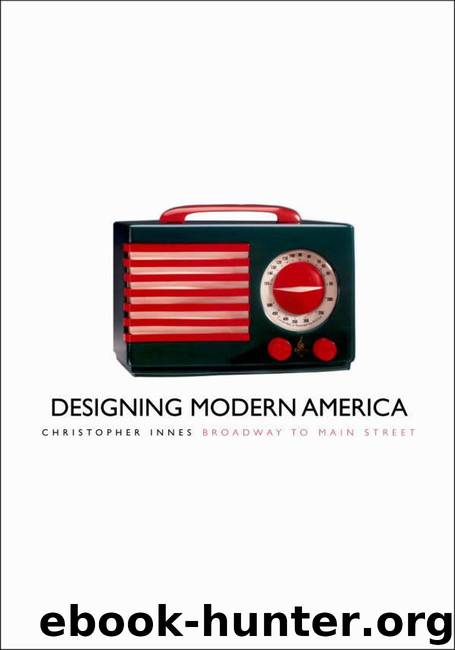Designing Modern America by Christopher Innes

Author:Christopher Innes
Language: eng
Format: mobi, epub
Publisher: Yale University Press
Published: 2005-12-14T22:00:00+00:00
An advertisement for Motorama, 1958. Billy Rose Theatre Collection, Courtesy of the New York Public Library for the Performing Arts, Astor, Lenox and Tilden Foundations.
By the 1950s Bel Geddes had withdrawn from car design, and it was left to another industrial designer, Raymond Loewy, to follow through on his more functional concept of streamlining. Loewy’s most famous car was the 1962 Studebaker Avanti, which returned to Bel Geddes’ principles and was so striking for its time in its simplified shape and absence of decorative chrome that it drew crowds in the streets. In other ways, too, the Avanti picked up on major elements from the cars Bel Geddes had designed for Nash almost a decade earlier: the wide frame, wings integrated with the body, panels covering the rear wheels, and a sloping semiteardrop trunk.
Loewy’s contribution has been rightly celebrated, and his debt to Bel Geddes forgotten, because his car designs anticipated the simplified shapes that came into vogue after the 1960s and have remained the basis for contemporary automobiles. Still, if any one person could be said to have determined the classic design of the American car, it is Bel Geddes. True, his patent for the rear-engine bubble-car of Futurama gathered dust in his files. But mock-ups for the “fish-tail" Cadillac of 1949, created by the General Motors styling studio, directly echoed Bel Geddes’ designs.16
He can also be indirectly credited with another type of car that later became an American favorite, and is with us still. It’s highly probable that he influenced the German engineers who produced a modified, but strikingly similar version to his concept of a small, rear-engine car in the Volkswagen.17 Bel Geddes had published his designs in 1932 in Horizons; and given the widespread interest his book attracted, it would be surprising if Volkswagen engineers had not come across it. And there was an even more direct link, since the first production-line model of the Volkswagen (limited because of the war to fourteen cars, which were used for publicity purposes) appeared in 1941, less than two years after the opening of the New York World’s Fair. Some of the Volkswagen designers might even have had opportunity to take Bel Geddes’ “Ride into the Future,” since when it opened in 1939 the fair included a German Pavilion (though in reaction to the war this was demolished before the 1940 re-opening of the fair). When the Volkswagen Beetle became a favorite American car—the “Love Bug” of the 1960s—this could in a sense be seen as a fulfillment of Bel Geddes’ vision.
However, the “Linear Look” Oldsmobiles and “Dagmar” Cadillacs, extended from his designs, most evoke the period. The elongated, low-slung bodies of the 1950s car, those prominent grills and flaring fins—which even when motionless, suggested the speed of a slipstream—expressed the self-confidence of America after the war.
The exaggerated appearance of streamlining captured the public imagination, as Bel Geddes with his theatrical experience had realized it would. The iconic styling of these cars, their wide bench seats and boldly curving windshields, all evolved directly out of his designs.
Download
Designing Modern America by Christopher Innes.epub
This site does not store any files on its server. We only index and link to content provided by other sites. Please contact the content providers to delete copyright contents if any and email us, we'll remove relevant links or contents immediately.
| Decorative Arts | Design History & Criticism |
| Furniture Design | Industrial & Product Design |
| Interior & Home Design | Jewelry Design |
| Textile & Costume |
POP by Steven Heller(2885)
Japanese Design by Patricia J. Graham(2556)
The Power of Broke by Daymond John(2377)
Architecture 101 by Nicole Bridge(2352)
Fusion 360 for Makers by Lydia Sloan Cline(1987)
Indistractable: How to Control Your Attention and Choose Your Life by Nir Eyal(1936)
Origami Art by Michael G. Lafosse & Richard L. Alexander(1737)
Actionable Gamification: Beyond Points, Badges, and Leaderboards by Yu-kai Chou(1724)
Batik by Rudolf Smend(1720)
Homebody by Joanna Gaines(1711)
Worn in New York by Emily Spivack(1619)
Feng Shui by Stephen Skinner(1616)
Whiskey in a Teacup by Reese Witherspoon(1577)
Austin Kleon by Steal Like an Artist(1537)
Don't Make Me Think, Revisited: A Common Sense Approach to Web Usability by Steve Krug(1530)
Simple Gatherings by Melissa Michaels(1512)
Hygge: The Danish Art of Happiness by Marie Tourell Søderberg(1429)
The Joy of Hygge by Jonny Jackson(1342)
The Laws of Simplicity by John Maeda(1301)
